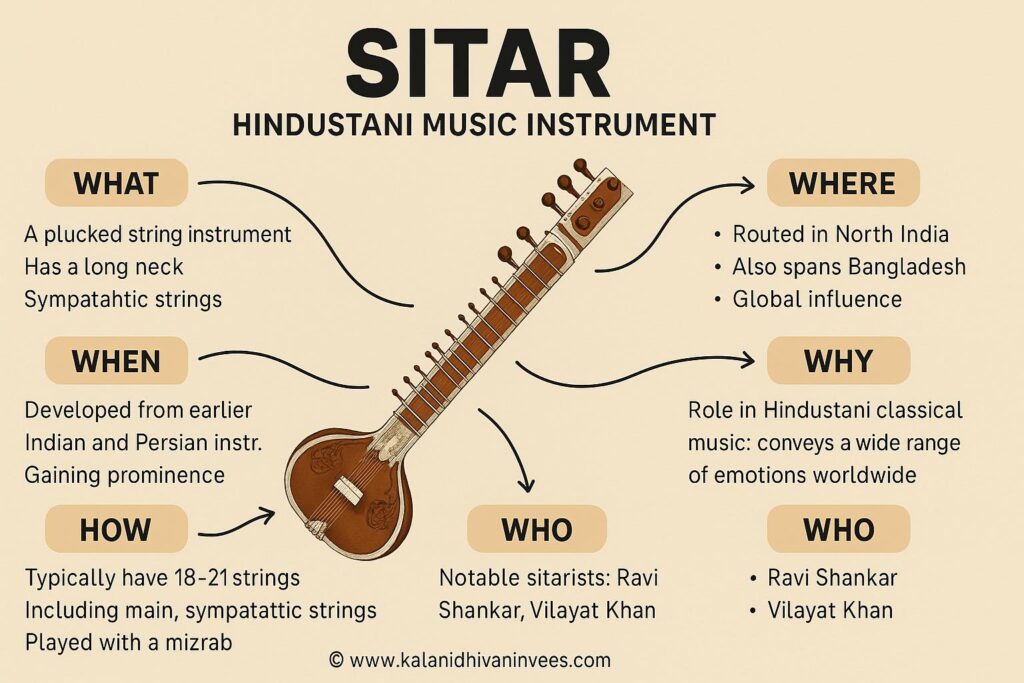Now Reading: Alhaiyā Bilāwal
-
01
Alhaiyā Bilāwal
Alhaiyā Bilāwal

Aesthetic and Structural Analysis of a Vakra Shuddha Rāga
(An In-depth Study with Chalan, Paltas, and Expression Techniques)
From Courtly Tradition to Classroom Practice: Rāga-Lakṣaṇa, Gamaka, and Vakratā in Alhaiyā Bilāwal
![]() Rāga: Alhaiyā Bilāwal
Rāga: Alhaiyā Bilāwal
Thāt: Bilāwal
Time of Performance: Morning (First prahar)
Jaati: Sampūrṇa–Sampūrṇa
Rāga Type: Shuddha-swar-based, with optional vivādi komal Ni
Style: Uplifting, devotional, courtly
⸻
![]() 1. Aroha / Avaroha (with stylistic variants)
1. Aroha / Avaroha (with stylistic variants)
Aroha (आरोह):
1. S R G R G P D N D Ṡ
2. S R G P D Ṇ Ṡ (simplified version)
3. S M G R G P D Ṡ (alternate vakra variation with Ma)
Avaroha (अवरोह):
1. Ṡ N D P D N D P M G M R S
2. Ṡ N D P M G R S (simple descent)
3. Ṡ D Ṇ P M G M R G S (Bhatkhande-style)
⸻
![]() 2. Vādī / Samvādī:
2. Vādī / Samvādī:
• Vādī: Dha
• Samvādī: Ga
Strong Dha–Ga emphasis; both used as nyās swaras (landing/resolution tones)
⸻
![]() 3. Pakad (Characteristic Phrase):
3. Pakad (Characteristic Phrase):
• G R G P D Ṇ S
• D G R G P M G R S
• Ṇ D Ṇ D P M G M R
• G M R G M P M G Ṇ Ṡ
⸻
![]() 4. Chalan (Flow of Movement):
4. Chalan (Flow of Movement):
• S R G P D Ṇ Ṡ
• Ṡ N D P D M G M R S
• D G R G P M G R S
• Ṇ S G M G R Ṇ D P
• G M G R G M D Ṇ S
• D Ṇ D P, D P G M G P M G Ṇ Ṡ
Smooth, vakra-oriented chalan with several sanchari ideas (melodic sidetracks)
⸻
![]() 5. Ang (Style / Flavor):
5. Ang (Style / Flavor):
• Linear in āroha, but vakra in avaroha
• Moderate use of kan swaras (especially Ni to Dha)
• Gamakas generally restrained
• Touches of shringar and bhakti rasa
• Frequently used in Thumri, Bandish, Khyal vilambit formats
⸻
![]() 6. Expression Techniques:
6. Expression Techniques:
![]() Kan (Grace Notes):
Kan (Grace Notes):
• Ni → Dha → P
• G → M in descent
• D → G (in vakra phrasing)
![]() Meend (Glide):
Meend (Glide):
• P ![]() M
M ![]() G
G
• Ṡ ![]() D
D ![]() Ṇ
Ṇ
![]() Andolan (Slow Oscillation):
Andolan (Slow Oscillation):
• On Dha (vādī)
• On Ga (samvādī)
⸻
![]() 7. Rasa (Emotional Essence):
7. Rasa (Emotional Essence):
• Śānta (Peaceful)
• Bhakti (Devotional)
• Śṛṅgāra (Delicate Romanticism)
Ideal for early morning mood. Smooth, elegant, and refined – neither overly melancholic nor overly exuberant.
⸻
![]() 8. Historical and Cultural Commentary:
8. Historical and Cultural Commentary:
• Name Origin: Possibly from “Alhaiyā” or “Alaiyā”, attributed to Amir Khusrau’s disciples composing on rāga Sarparda in honor of their teacher, Ala-ud-din Rahmat.
• Medieval Usage: Also mentioned in works by Nayak Bakshu during the 16th century under Raja Man Singh Tomar (Gwalior)
• 20th Century Practice: V.N. Bhatkhande considered this rāga as the primary “Bilāwal” of his era
• Modern Use: Preferred in classical khyal and light classical (especially bhajan, thumri)
⸻
![]() 9. Comparison with Śuddha Bilāwal:
9. Comparison with Śuddha Bilāwal:
• Both use all shuddha swaras
• Alhaiyā Bilāwal has:
• Vakra Ma
• Optional komal Ni (as vivādi or kan)
• Nyās and nyās-oriented movements on Ga, Dha
• Greater use of ornamentation and zigzag flow
⸻
![]() 10. Bandish Examples (Compositions):
10. Bandish Examples (Compositions):
• Vilambit: “Dājī khāṭ gayē log” – Teentāl
• Madhyalaya: “Kavanā bāriyā gailo” – Teentāl
• Other themes: Bhajans, Hori, spring ritu-based compositions
⸻
![]() 11. Performance Observations:
11. Performance Observations:
• Requires clarity in swara touch (particularly with kan from Ni)
• Use and omission of komal Ni must be contextual and not overused
• Smooth transitions and well-placed nyās swaras bring beauty
• Works beautifully with tanpura drone and madhyam tuning
⸻
![]() 12. Parallel Systems Mapping:
12. Parallel Systems Mapping:
![]() Western Equivalent:
Western Equivalent:
• C Ionian (Major Scale): C D E F G A B C
• Difference: Alhaiyā Bilāwal may include B♭ (komal Ni) in descent
![]() Carnatic Equivalent:
Carnatic Equivalent:
• Closest: Rāga Gaula (Janya of Melakarta 29 – Dheerashankarabharanam)
• Mood: Devotional, early morning raga
• Style: Gaula uses kampita gamakas, vakra movement, same shuddha swaras
1. #ABilāwal – Short for Alhaiyā Bilāwal, a vakra rāga of the Bilāwal thāt
2. #VakraRāga – A rāga with zigzag, non-linear swara movement
3. #RāgaChitra – Rāga illustrated as an image or infographic
4. #MorningRāga – Rāga suited for early morning (1st prahar) performance
5. #RāgaLakṣaṇa – The structural and defining traits of a rāga
6. #ChalanFlow – The characteristic melodic movement or phrases
7. #ArohaAvroha – Ascending and descending scale of a rāga
8. #RasaMap – Mapping the emotional flavors (rasa) evoked by the rāga
9. #ShuddhaStyle – Refers to pure (natural) swaras used in the rāga
10. #Vakratā – Zigzag swara motion, a stylistic hallmark
11. #SwarSculpt – Artistic shaping of notes with ornamentation
12. #NyāsPower – Emphasis on resting/landing notes (nyās swaras)
13. #DhaGaAxis – Vādī-samvādī pair defining melodic balance (Dha–Ga)
14. #KanTouch – Grace note embellishments in swara transitions
15. #MeendMagic – Gliding transitions between swaras
16. #AndolanSway – Gentle oscillation of notes (esp. Ga, Dha)
17. #ThumriVibe – Light classical feel, often devotional or romantic
18. #ŚṛṅgāraMood – Romantic essence associated with this rāga
19. #BhaktiRāga – Devotional energy evoked by the melody
20. #ŚāntaTone – Peaceful and contemplative mood
21. #SanchāriPlay – Melodic sidetracks within the rāga framework
22. #GamakaArt – Ornaments and expressive note techniques
23. #ClassicalCanvas – The use of rāga as a visual artistic metaphor
24. #HindustaniCore – Refers to foundational elements of North Indian music
25. #BandishCode – Composition-based identity of a rāga
26. #NādaYoga – Sonic/spiritual connection via pure sound
27. #TanpuraSoul – The harmonic drone enhancing rāga mood
28. #RaagIdentity – What gives a rāga its unique musical DNA
29. #VisualRāga – Turning music into imagery and visual learning
30. #VakraBeauty – The beauty in non-linear melodic movement
























